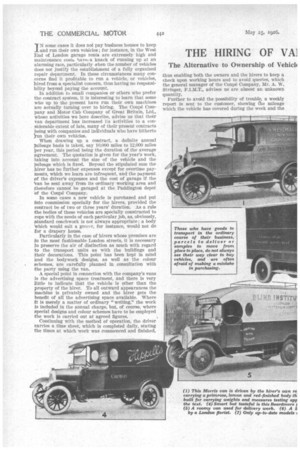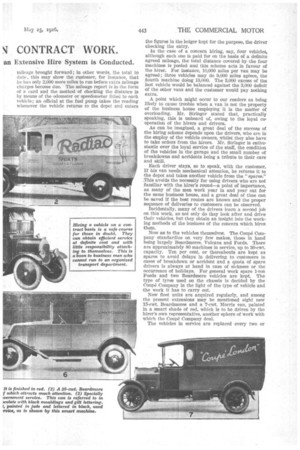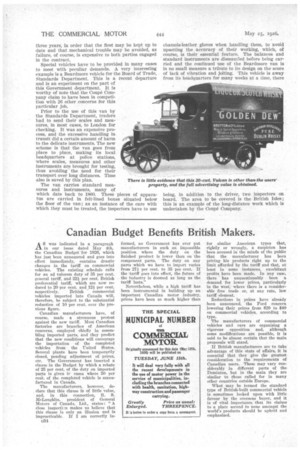THE HIRING OF V.A.] The Alternative to Ownership of Vehicll
Page 16

Page 17

Page 18

If you've noticed an error in this article please click here to report it so we can fix it.
SI CONTRACT WORK.
an Extensive Hire System is Conducted. TN some cases it does not pay business houses to keep -Land run their own vehicles; for instance, in the West End of London garage rents are extremely high and maintenance costs havefa knack of running up at an alarming race, particularly when the number of vehicles does not justify the establishment of a fully organized repair department. In these circumstances many concerns find it profitable to run a vehicle, or vehicles, hired from a specialist concern, thus having no responsibility beyond paying the account.
In addition to small companies or others who prefer the contract system, it is interesting to learn that some who up to the present have run their own machines 'are actually turning over to hiring_ The Coupe Company and Motor Cab Company of Great Britain, Ltd., whose activities we here describe, advise us that their van department has increased its activities to a considerable extent of late, many of their present contracts 'being with companies and individuals who have hitherto 1.1n their own vehicles.
When drawing up a contract, a definite annual )nileage basis is taken, say 10,000 miles to 12,000 miles Per year, this period being the duration of the average agreement. The quotation is given for the year's work, ?taking into account the size of the vehicle and the Mileage which is fixed. Beyond the stipulated sum the hirer has no further expenses except for overtime payments, which we learn are infrequent, and the payment pf the driver's expenses and the cost of garage if the 'van be sent away from its ordinary working area and therefore cannot be garaged at the Paddington depot of the Coupe Company.
In some cases a new vehicle is purchased and put into commission specially for the hirers, provided the contract be of two or three years' duration. As a rule the bodies of these vehicles are specially constructed to cope with the needs of each particular job, as, obviously, standard coachwork is not always appropriate; a body Which would suit a grocer, for instance, would not do for a drapery house.
Particularly in the ease of hirers whose premises are in the most fashionable London streets, it is necessary 'to preserve the air of distinction as much with regard to the transport units as with the buildings and their decorations. This point has been kept in mind 'and the bodywork designs, as well as the colour schemes, are carefully planned in consultation with the party using the van.
A special point in connection with the company's vans Is the advertising space treatment, and there is very little to indicate that the vehicle is other than the property of the hirer. To all outward appearances the machine is privately owned and the hirer gets the benefit of all the advertising space available. Where is merely a matter of ordinary "Writing," the work is included in the annual charge, but, of course, where special designs and colour schemes have to be employed the work is carried out at agreed figures.
Continuing with the method of operation, the driver carries a time sheet, which is completed daily, stating the times at which work was commenced and finished, thus enabling both the owners and the hirers to keep a check upon working hours and to avoid queries, which the general manager of the Coupe Company, Mr. A. W.
Stringer, advises us are almost an unknown quantity.
Further to avoid the possibility of trouble, a weekly report Is sent to the customer, showing the mileage which the vehicle has covered during the week and the mileage brought forward; in other words, the total to date, this may show the customer, for instance, that lie has only 2,000 more miles to run before extra mileage charges become due. The mileage report is in the form of a card and the method of checking the distance is by means of the odometer or speedometer fitted to each vehicle; an official at the fuel pump takes the reading whenever the vehicle returns to the depot and enters the figures in the ledger kept for the purpose, the driver checking the entry.
In the case of a concern hiring, say, four vehicles, although each one is paid for on the basis of a definite agreed mileage, the total distance covered by-the four machines is pooled and this scheme acts in favour of the hirer. For instance, 10,000 miles per van may be agreed; three vehicles may do 9,000 miles apiece, the fourth machine doing 13,000. The 3,000 excess of the last vehicle would be balanced against the 3,000 deficit of the other vans and the customer would pay nothing extra.
A point which might occur to our readers as being likely to cause trouble when a van is not the property of the business house employing it is the matter of overloading. Mr. Stringer stated that, practically speaking, this is unheard of, owing to the loyal cooperation of the hirers and drivers.
As can be imagined, a great deal of the success of the hiring scheme depends upon the drivers, who are in the employ of the vehicle owners, whilst they also have to take orders from the hirers. Mr. Stringer is enthusiastic over the loyal service of the staff, the condition of the vehicles in the garage and the small number of breakdowns and accidents being a tribute to their care and skill.
Each driver stays, so to speak, with the customer. If his van needs mechanical attention, he returns it to the depot and takes another vehicle from the " spares." This avoids the necessity for using drivers who are not familiar with the hirer's round—a point of importance, as many of the men work year in and year out for the same business house, and a great deal of time can be saved if the best routes are known and the proper sequence of deliveries to customers can be observed.
Incidentally, many of the drivers learn a second job on this work, as not only do they look after and drive their vehicles, but they obtain an insight into the working methods of the business of the concern which hires them.
Now as to the vehicles themselves. The Coupe Company standardize on very few makes, those in hand being largely Beardmores, Vulcans and Fords. There are approximately 80 machines in service, up to 30-cwt. capacity. Ten per cent, or thereabouts are kept as spares to avoid delays in delivering to customers in cases of breakdown or accident and a quota of spare drivers is always at hand in case of sickness or the occurrence of holidays. For general work spare 1-ton Fords and two Beardmore vehicles are kept. The type of tyre t used on the chassis is decided by the Coupe Company in the light of the type of vehicle and the work it has to carry out.
New fleet units are acquired regularly, and among the present extensions may be mentioned eight new 15-cwt. Beardmores and a 7-cwt. Morris van, painted in a smart shade of red, which is to be driven by the hirer's own representative, another sphere of Work with which the Coupe Company deal.
The vehicles in service are replaced every two or
three years, in order that the fleet may be kept up to date and that mechanical trouble may be avoided, as failure, of course, is expensive to both parties engaged in the contract.
Special vehicles have to be provided in many cases to meet with peculiar demands. A very interesting example is a Beardmore vehicle for the Board of Trade, Standards Department. This is a recent departure and is an experiment on the part of this Government department. It is worthy of note that the Coupe' Company claim to have been in competition with 26 other concerns for this particular job.
Prior to the use of this van by the Standards Department, traders had to send their scales and measures, in most cases, to London for checking. It was an expensive process, and the excessive handling in transit did a certain amount of harm to the delicate instruments. The new scheme is that the van goes from place to place, making its local headquarters at police stations, where scales, measures and other instruments are brought for testing, thus avoiding the need for their transport over long distances. Time also is saved by this plan.
The van carries standard measures and instruments, many of which date back to 1860. These pieces of apparatus are carried in felt-lined boxes situated below the floor of the van; as an instance of the care with which they must be treated, the inspectors have to use chamois-leather gloves when handling them, to avoid upsetting the accuracy of their working, which, of course, is their essential feature. The balances and standard instruments are dismantled before being carried and the continued use of the Beardmore van is in no small measure a tribute to its design on the score of lack of vibration and jolting. This vehicle is away from its headquarters for many weeks at a time, there
being, in addition to the driver, two inspectors on board. The area to be covered is the British Isles; this is an example of the long-distance work which is undertaken by the Coupe Company.


























































